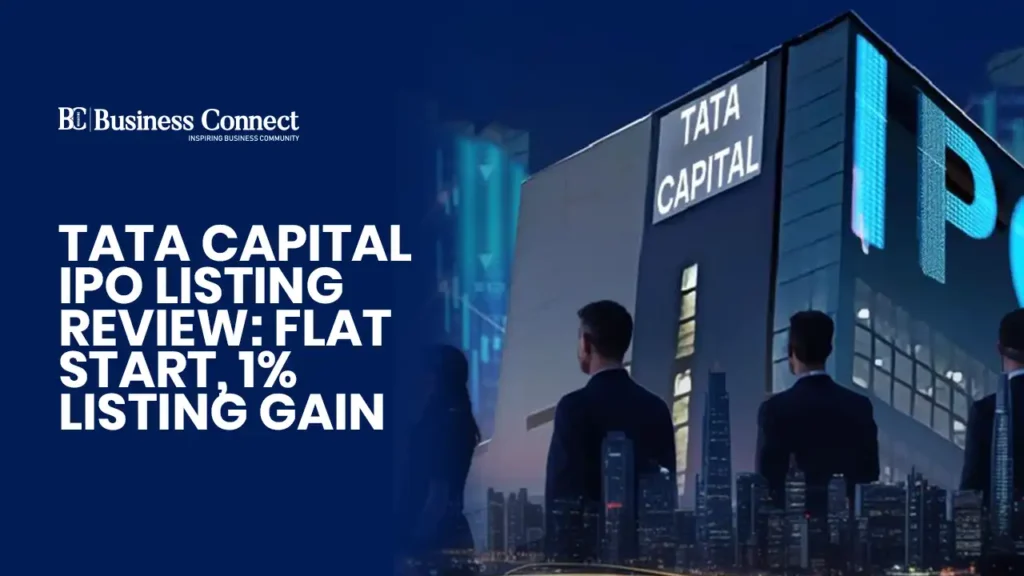The BSE and NSE listed Tata Capital’s shares for ₹330, which was 1.23% more than the issue price of ₹326. Brokerages Emkay Global and JM Financial began counter covering with ‘Add’ ratings ahead of today’s Tata Capital IPO filing.
Tata Capital IPO Listing: On Monday, October 13, Tata Capital’s 2025 biggest initial public offering (IPO) made a modest beginning on the Indian stock exchange. Tata Capital’s share price was listed at ₹330 on the BSE and NSE, which was 1.23% more than the issue price of ₹326.
Tata Capital’s share price, however, dropped slightly to ₹326.85 on the NSE after listing, but it was still higher than the IPO price.
Is it wise to purchase shares in Tata Capital?
Brokerages Emkay Global and JM Financial began counter covering with ‘Add’ ratings ahead of today’s Tata Capital IPO filing. However, they have set ₹360 as their target price for Tata Capital shares, indicating little room for further growth. With the help of the vehicle finance business’s turnaround and a high secured share in the product mix, Emkay Global said its positive stance on the Tata group company is based on a number of factors, including: 1) the Tata parentage and brand name providing the essential ingredients; 2) a diversified product range, geographical reach, and various sourcing channels minimizing concentration risk; and 3) improving credit costs and operating leverage likely driving sustained RoA/RoE improvement to ~2.2%/15.4% in FY28E and >30% EPS growth in FY25-28E.
According to JM Financial, TCL’s current projected value multiple is about 2.7 times FY27E P/BV at the IPO top price range of INR 326. TCL should trade between CIFC and HDB, which have value multiples of 3.7x and 2.5x FY27E P/BV, respectively, based on its AUM growth and RoE profile. “We set a target multiple of 2.9x FY27E BVPS for TCL, which represents a premium/discount of approximately 10% to 12% to HDB Financial/CIFC,” stated JM Financial.
Details of the Tata Capital IPO
The Tata Capital initial public offering (IPO) was booked 1.95 times between October 6 and October 8. 65,12,29,590 shares were bought on in the ₹15,512 crore share sale, out of the 33,34,36,996 shares that were up for grabs.
The sector intended for non-institutional investors (NIIs) obtained 1.98 times as many subscriptions as the qualified institutional buyers (QIBs) segment, which received 3.42 times as many. 1.10 reservations were made in the retail sector.
At the higher end of the pricing range, the non-banking financing firm was valued at ₹1.38 lakh crore, with the Tata Capital IPO price range being set at ₹310-326 per share.
The issuance included both an offer for sale (OFS) of 26.58 crore shares and a new share sale of 21 crore equity shares. In order to meet future capital needs, such as onward lending, the firm intends to fortify its Tier-1 capital base using the IPO proceeds from the new offering.
With the solid support of the Tata group, Tata Capital, one of India’s top and most diverse NBFCs, was founded in 2007. Eighty percent of the company’s operations are in secured business categories.
With more than 25 different lending products, Tata Capital may be essentially divided into three business categories. Retail financing accounts for 61% of its loan book, followed by SME loans (26%), and corporate loans (13%).
Its AAA/Stable credit grade allows it to easily acquire cash at reduced interest rates.
Disclaimer: The sole intention of this narrative is education. Business Connect Magazine does not endorse the opinions or suggestions made by individual analysts or brokerage companies. Since situations can change and market conditions can change quickly, we suggest investors to seek advice from recognized specialists before making any investment choices.
Add Business Connect magazine to your Google News feed
Must Read:-
- Larry Ellison of Oracle Suddenly Overtakes Elon Musk as the Richest Person in the World
- Top 10 Richest Comedians In India
- Top 10 Richest Pakistani Actress in 2025 – Who Is Your Favorite?
- Majhi Ladki Bahin Yojana 2025: Benefits, Registration & KYC Guide
- Discover What Sets the Best Global Business Magazines Apart for Entrepreneurs



